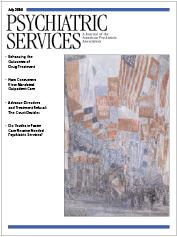Brief Reports: A Program to Reduce Use of Physical Restraint in Psychiatric Inpatient Facilities
Abstract
The authors describe a program to reduce the use of physical restraint on three psychiatric units of a university hospital. One component of the program involved interviewing patients to determine their stress triggers and personal crisis management strategies. The second consisted of training staff members in crisis deescalation and nonviolent intervention. During the first two quarters after implementation of the program, physical restraint rates declined significantly and remained low on all three units for the remainder of the year after implementation. Hospitals should consider instituting comprehensive staff training that encourages adaptive patient behaviors and nonviolent staff intervention to reduce the physical and mechanical restraint of children and adults in inpatient facilities.



